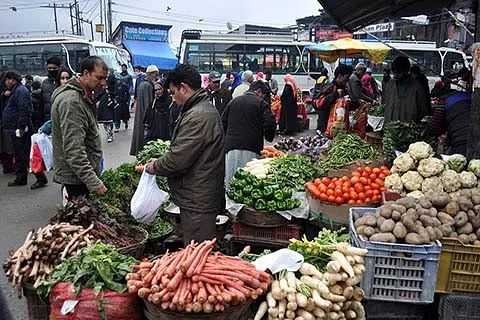In Kashmiri a modest way of saying that for surviving and spending an austere but a complete life is to have enough “Haakh Batta” (Haakh and rice). This is beyond the level of prosperity, caste and religious lines. Somewhat akin to Dal-Roti of North India.
Haakh or Collard is a loose-leafed vegetable of Brassica oleracea species. This is a common species for vegetables like cabbage, broccoli etc. These plants are grown as a food crop for their edible large leaves, which are cooked and consumed with the main meal.
In India it largely produced in Kashmir but is a part of international cuisine for the last more than 2000 years. These geographies are, Brazil, Portugal, Zimbabwe, South Africa, Tanzania, Uganda, Kenya the Balkans and Spain.
There is also historical evidence that ancient Greeks cultivated many types of the plant. The plant is commercially cultivated for its slightly thick dark green leaves, which are slightly bitter.
One of the beauties of this plant is that it is available all around the year. However, the leaves of winter and early spring are tastier and very tender.
Raw Haakh has 90% water, 6% carbohydrates, 3% protein and is fat free. In terms of vitamins, it has substantial amounts of Vit K and is a rich source of Vit A, C, B6 and manganese. It also is rich in glucosinolates which gives it a bit of a pungent taste but is known to be protective against prostate, Colo-rectal and breast cancers.
Haakh leaves are harvested by pinching in early spring when the dormant buds sprout and give out tender leaves (Kannul). When the growing stem bears bigger leaves in quick succession the older and bigger leaves are harvested periodically. In late autumn, the apical portion of the stem is removed along with whorled leaves.
The quality and taste of haakh, according to the connoisseurs, varies according to the place in the city where is grown. Traditionally haakh used to be grown in large fields but these areas have shrunk considerably.
The owners have started making buildings often commercial ones on these fields. However still there are areas in Radpora, Kawdora, Khanayari and Baba Demb, which are the remnants of what used to be sprawling farms catering to the large demands of the city.
The haakh grown in Dal Lake is called Haanz haakh (boatman’s haakh) and is distinctly different in looks, colour and taste than the land grown varieties.
The vagaries of weather have really affected the cultivation of this traditional Kashmiri vegetable. The disastrous floods of 2014 inundated several parts of the city including the treasured areas of haakh cultivators. The soil quality became very unhealthy and not sustainable for good quality. Many of the cultivators have shifted towards growing other vegetables like cabbage which has a better market across the country and lasts for longer. All this has resulted in a steep rise in its cost as high as Rs 80 per Kg.
The rains led to unprecedented increase in the water levels in Dal Lake and drowned the cultivation. This coupled with administration relocating the dwellers of Dal area to different areas of the city like Bemina, Mehjoor Nagar etc., without understanding its economic implications. This has led them to part away with their haakh cultivation. Most have gone for other jobs like vegetable vendors and masons etc in the ever-growing building activities of the city.
Cooking Haakh in its simplest and the traditional form is easy. Clean it by washing, remove the tough fibrous stem. Cook with a little mustard oil after heating it till it becomes very hot, check it by putting a few drops of water on it. Put the haakh leaves either as such or if very large by dividing in two by hand, add a few green chillies asafoetida (batta haakh) or garlic (Muslims often use it) and very little water. In order to maintain its green colour a dash of soda bi carb (phul) is recommended by some experts. It is best cooked in an open vessel without a lid, but the summer varieties being tougher would take longer time. An alternative is to cook in a pressure cooker and allow only a few whistles. Immediately open the lid by pouring cold water on the closed lid so as to allow opening it. Leave the lid open thereafter to maintain its green colour. Occasionally haakh is pounded after being cooked and drained and consumed as such (Dagith Haakh). This is usually made for a person who is recouping from a recent illness.
Haakh is also cooked variously with paneer (Haakh Chaaman ), mutton (Haakh maaz) with dried fish and smoked fish (Hogada haakh) etc . In good old days several decades ago haakh leaves used to be dried and kept for use in winter. It was for those days of heavy snowfall making it difficult for people to go to market to buy it.
Haakh is thus identified as an essential and every day accompaniment of a Kashmiri meal, both a frugal one or as a part of Wazwan.
Aai Haakh , Che Kati Aakh (Oh haakh , where from did you come?)
Na chae adjee, naa che paakh (You have no bones and so easy to cook)
Dar khanay Mama Tak (You reside in every home, including Mama Tak’s)
Chukh na garas manz te che baakh (if not in kitchen, it makes us cry)
Prof Upendra Kaul , Founder Director, Gauri Kaul foundation
Disclaimer: The views and opinions expressed in this article are the personal opinions of the author.
The facts, analysis, assumptions and perspective appearing in the article do not reflect the views of GK.







